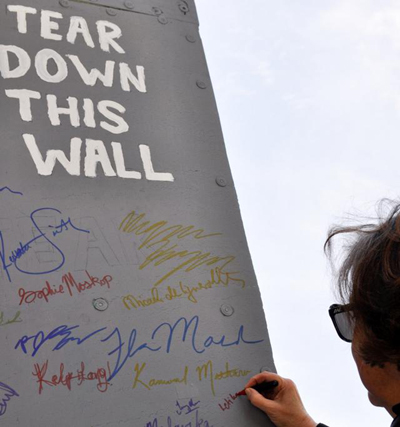 |
| A visitor signs a wall erected outside Frist Campus Center to protest the wall constructed by Israel that divides the West Bank. (Gerald Vong) |
|
For eight hours on Thursday, students walking by the north lawn outside
Frist Campus Center were greeted by a 16-foot wall made of wood and
Styrofoam — a symbolic representation of the wall dividing the West
Bank, which has sparked extensive disagreement and conflict.
The
display was a protest by the Princeton Committee on Palestine and
Amnesty International against the wall erected by the Israeli
government, which separates stretches of Israel and the West Bank.
PCP
and Amnesty International members spent the past few months planning,
building and painting the wall, which was marked with the words “peace
not apartheid.”
PCP president Yoel Bitran ’11 said in an e-mail
that the group wanted to “give Princeton students the opportunity to
imagine what it would be like to grow up or go to school in a place
surrounded by a prison of concrete and metal.”
He said that while
“most students understand that Israel’s policies in the occupied
territories are fundamentally wrong,” the group aims to “help people
understand the suffering of Palestinians and realize the urgency of
doing something about it.”
“We hope to let people know that there
is a strong and growing movement for Palestinian rights at Princeton …
and that being part of this historic struggle is possible right here,”
Bitran added.
But Jeffrey Mensch ’11, president of Tigers for Israel, dismissed the protesters’ claims.
He
said in an e-mail that the group was “concerned about the absurd claim
that Israel’s security fence, instituted to prevent suicide terrorist
attacks against Israeli civilians, constitutes an ‘Apartheid Wall.’ ”
Mensch explained that Palestinian concerns about the wall should be addressed by Israel’s government.
“While
we are concerned by the impacts of the wall on the lives of Palestinian
civilians who live near the fence,” Mensch said, “these are and should
be addressed in the Israeli Supreme Court, which has a strong record of
considering the complaints of Palestinians on such issues.”
Amnesty
International president and PCP member Megan Hogan ’12 said in an
e-mail that her group hopes the display will not only remind students
of human rights abuses around the world, but will offer them an
opportunity to speak out against such violations.
“We hope that
seeing a ... wall in front of Frist will inspire people to take a
moment to sign a petition or handwrite a letter protesting human rights
abuses stemming from the Israeli-Palestinan conflict,” she explained.
Amnesty
International has collected 124 signatures for a petition supporting
human rights activists who were jailed for nonviolently protesting the
wall dividing the West Bank, and 109 signatures for a petition
protesting the $3 billion in military aid that President Barack Obama
has asked Congress to send to Israel next year, Hogan said.
While Mensch disagreed with the politics of the display, he did not challenge the University’s approval of the event.
“Of
course, Tigers for Israel does not shun discussion of the difficult
issues — indeed, we welcome it,” he said. “It is important that
difficult issues like the wall are discussed on campus.”
After
the event, Hogan said, she was “touched and amazed by the number of
students, faculty and community members who approached us to thank us
for what we are doing.” Hogan added that the gratitude “made me realize
just how vitally necessary such events are.”
Alex Smith ’13, a
PCP member who helped plan the project, said in an e-mail that he hopes
students who saw the display will attempt to look further into the
conflict.
“More than anything, I would hope that students take
away an understanding that there are two sides to this conflict,” Smith
said. “Then, I feel that it is up to the students to research the topic
and seek to understand it.”
Though the display has been dismantled, Bitran said that the protesters’ work still continues.
“The
objective is to raise awareness about this issue, but more importantly,
we hope to inspire people to join the global movement against Israeli
apartheid, to help us fight for Palestinian rights and ultimately
participate in the effort to bring this conflict to an end,” he said.
The Daily Princetonian

